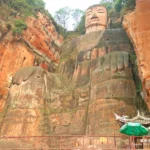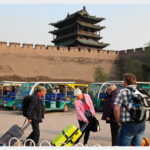Discover everything you need to know about visiting the Summer Palace in Beijing! This guide covers detailed maps, the best routes to explore, snack options, ticket information, and practical tips for making the most of your visit. Whether you’re a first-timer or a frequent traveler, this guide has you covered!
1. Getting to Know the Summer Palace
Nestled in the Haidian District on the western edge of Beijing, the Summer Palace is a masterpiece of royal landscaping, often called the “Royal Garden Museum.” This beautiful garden was first created in 1750 under the reign of Emperor Qianlong. Originally known as Qingyi Garden (清漪园), it was later rebuilt in 1886 and renamed the Summer Palace (颐和园).
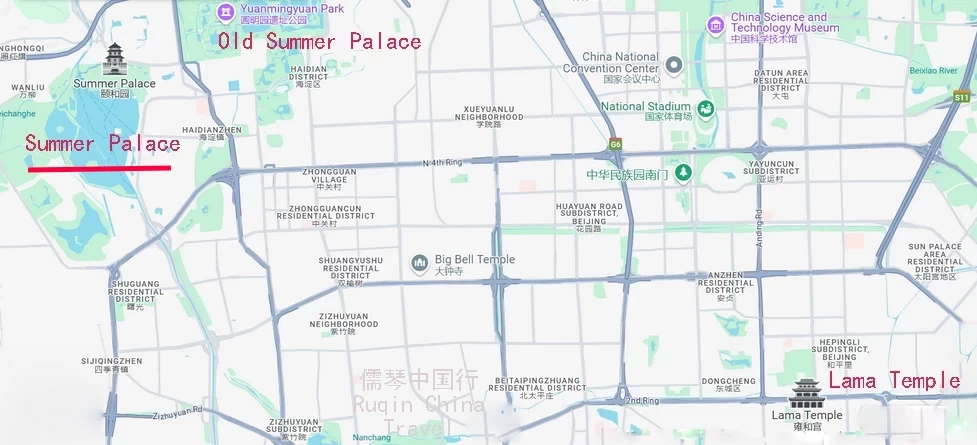
Spanning over 3 square kilometers, the Summer Palace is a wonder of natural and architectural harmony. Around three-quarters of the space is covered by the tranquil Kunming Lake (昆明湖), while Longevity Hill (万寿山), offers a stunning backdrop. As you wander through the grounds, you’ll encounter over 100 picturesque buildings, 20 courtyards, and more than 3,000 ancient structures, all surrounded by over 1,600 centuries-old trees.
What makes the Summer Palace truly special is its ability to seamlessly blend nature with human design. The park embodies the traditional Chinese principle of creating landscapes that feel naturally formed, even though they were meticulously planned.
The garden’s history is as rich as its beauty. It was built during the Qianlong era to demonstrate the wealth and grandeur of the imperial family. Its design combines the artistic traditions of the Jiangnan region, showcasing exceptional craftsmanship and cultural depth.
Sadly, the Summer Palace was burned down by the British and French in 1860. However, it was rebuilt during the reign of Emperor Guangxu and has undergone several restorations to reach its current glory.
Today, the Summer Palace stands as a pinnacle of Chinese garden artistry, joining the ranks of other famous gardens like the Chengde Mountain Resort and the Suzhou Gardens. It remains a must-see destination for visitors from all over the world.
2. How to Get to the Summer Palace
The Summer Palace, with its grand design and rich history, is accessible through six different entrances, but the three main gates—North Palace Gate (North Gate) 北宫门, East Palace Gate (East Gate) 东宫门, and New Palace Gate (Southeast Gate)—are the most popular for visitors.
| North Palace Gate 北宫门 | East Palace Gate 东宫门 | New Palace Gate 新建宫门 |
| South Ruyi Gate 南如意门 | North Ruyi Gate 北如意门 | Summer Palace West Gate 颐和园西门 |
Here’s a guide to reaching the three primary gates, mainly using Beijing’s convenient subway and bus networks.
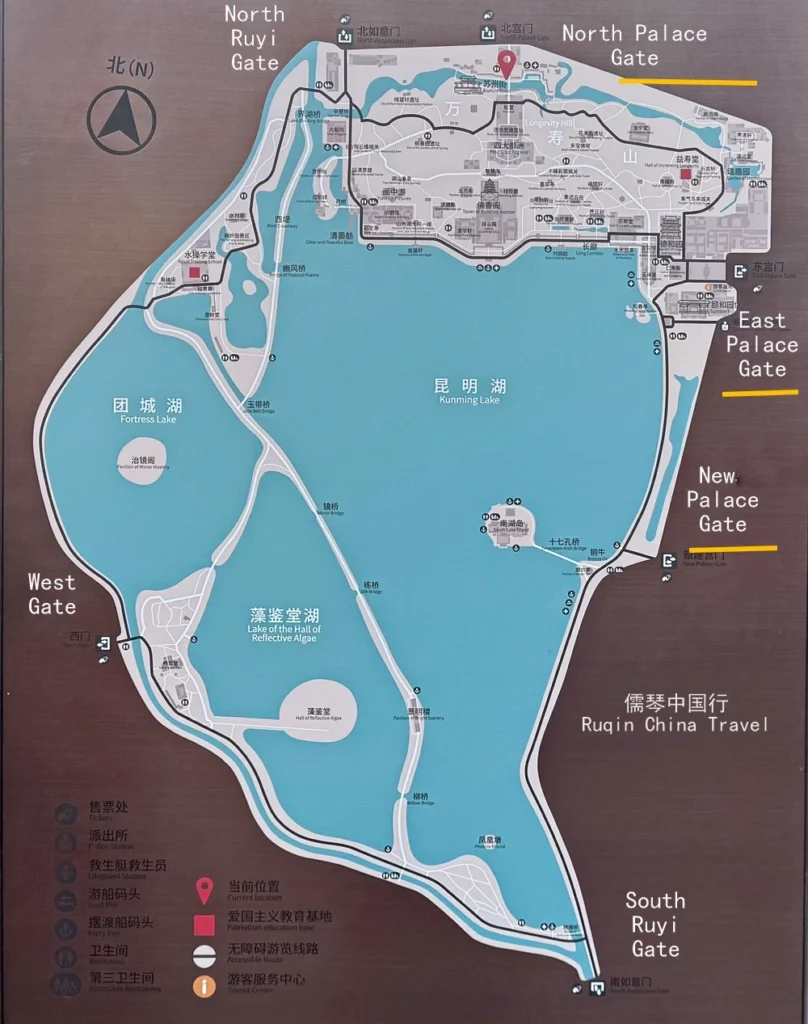
Summer Palace Official Address:
19 Xinjian Gongmen Road, Haidian District, Beijing
北京市海淀区新建宫门路19号
Phone: 010-62881144
North Palace Gate (Beigongmen) 北宫门
As one of the most frequently used entrances, Beigongmen sees large crowds of visitors, especially during peak tourist seasons.
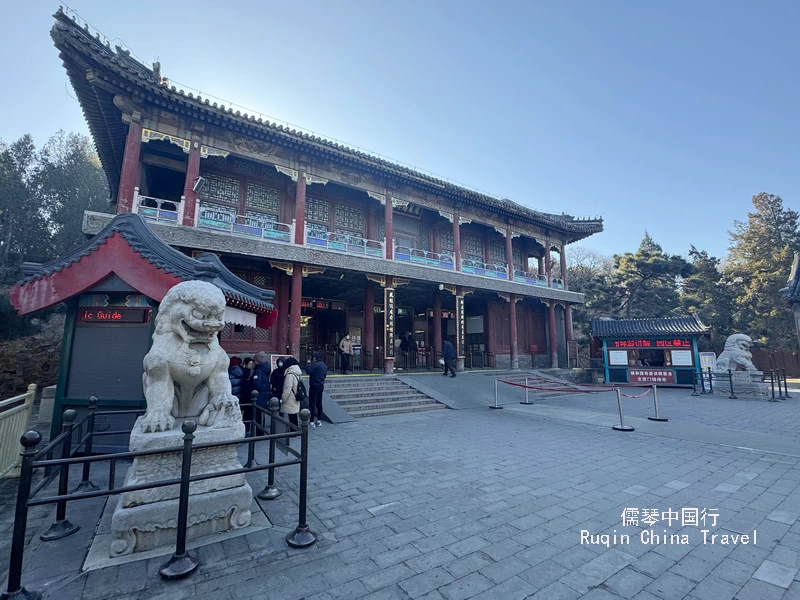
This gate is a popular starting point for those exploring the northern areas of the park such as Suzhou Street, Four Great Continents, Marble Boat, Travel in Picture and more.
- Subway: Line 4, Beigongmen Station
- Bus: Routes 303, 332, 384, 394, 563, 584, 601, Night Bus 8
- Parking: Temporary parking available nearby
East Palace Gate (Donggongmen) 东宫门
The East Gate is considered the main entrance to the Summer Palace. Located near iconic landmarks such as Renshou Hall, Jingfu Pavilion, and the Long Corridor, it’s the ideal entry for visitors keen on exploring the park’s architectural marvels. There is one Beijing Bank ATM located at the East Palace Gate.
- Subway: Lines 4 and 16, Xiyuan Station
- Bus: Routes 332, 584, 346
- Parking: Limited parking space available nearby
New Palace Gate (Xinjian Gongmen) 新建宫门
Located south of the East Palace Gate, Xinjian Gongmen is a newer entrance that also attracts many visitors. It’s conveniently close to the 17-Arch Bridge, the Bronze Ox, and the famous Knowing in the Spring Pavilion.
- Subway: A 15-minute walk from Xiyuan Station (Lines 4 & 16)
- Bus: Routes 374, 74, 437
- Parking: Parking available nearby
3. The Best Travel Route for First-Time Visitors
Visiting the Summer Palace for the first time can be overwhelming with its six entrances and exits. To help you make the most of your visit, we’ve recommended the best travel route for first-timers.
Start by taking Subway Line 4 and alight at Beigongmen Station. Exit through Exit D. Once outside, turn around and walk along the high wall on your left for about 300 meters. This will bring you to the North Palace Gate (Beigongmen), where your adventure begins.
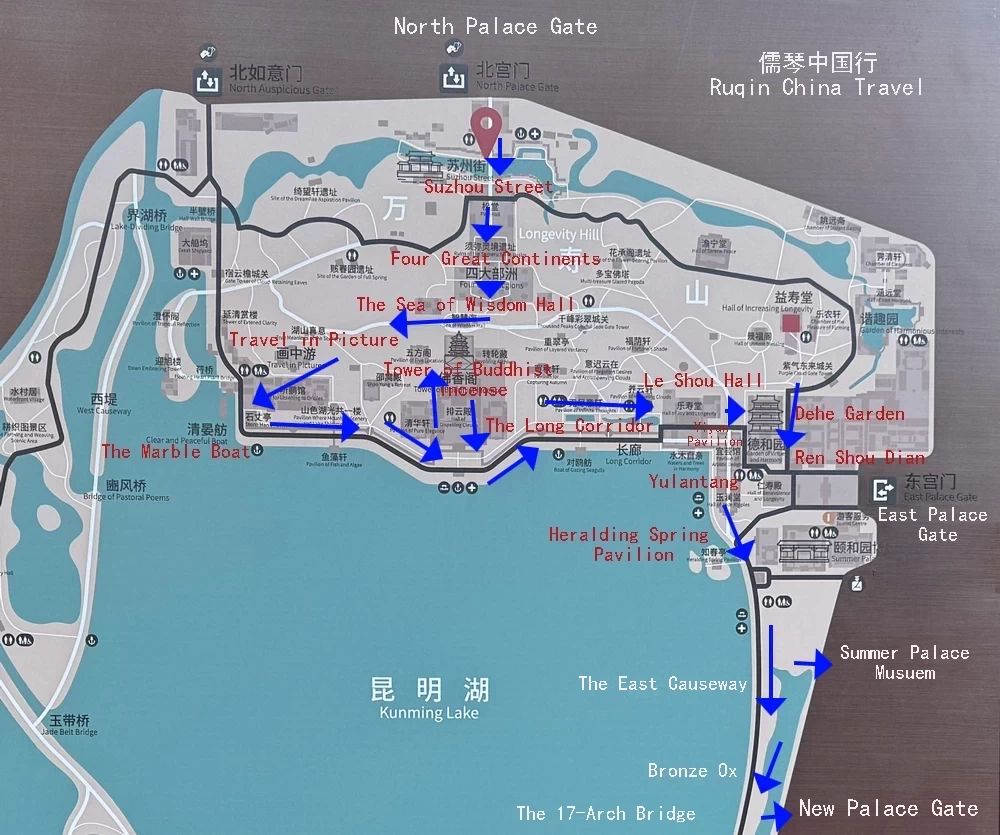
From the North Gate, your first stop is Suzhou Street (currently under construction, but still visitable). Afterward, head up the rear mountain of Longevity Hill. On your way up, visit the Four Great Continents located along the slope.
Continue your hike to the summit of Longevity Hill, turn right, passing the Hall of Sea of Wisdom. Then, descend to the front of Longevity Hill and enjoy the “Travel in Picture” area. Don’t miss the Marble Boat, a stunning highlight. Afterward, take a relaxing stroll along the Long Corridor.
Next, make your way back up to the top of Longevity Hill from the from mountian to visit the Tower of Buddhist Incense. Take in the full views of the Summer Palace, then hike down to continue your exploration.
Walk along the Long Corridor again and visit several more notable sites: the Hall of Joy and Longevity, the Pavilion of Artistic Delight, the Garden of Virtue and Harmony, the Hall of Jade Ripples, and the Hall of Benevolence and Longevity.
Finish your journey by strolling along the East Causeway, where you’ll find the Summer Palace Museum, the Bronze Ox, and the iconic 17-Arch Bridge. Exit through the New Palace Gate to complete your tour.
Highlights of the Best Travel Route for First-Time Visitors at the Summer Palace:
1)Exploring Suzhou Street: A Glimpse of Ancient Imperial Shopping
Nestled by the tranquil waters of Suzhou River, Suzhou Street (苏州街)offers a unique walk back in time. Originally called Wanshou Shopping Street, it was built under Emperor Qianlong’s orders to recreate the charm of Jiangnan’s water towns. This enchanting street was once a place for the Qing emperors and empresses to leisurely stroll, shop, and enjoy the local market. Interestingly, the shopkeepers were eunuchs and palace maids in costume, creating an authentic imperial atmosphere. The street came to life only during imperial visits.
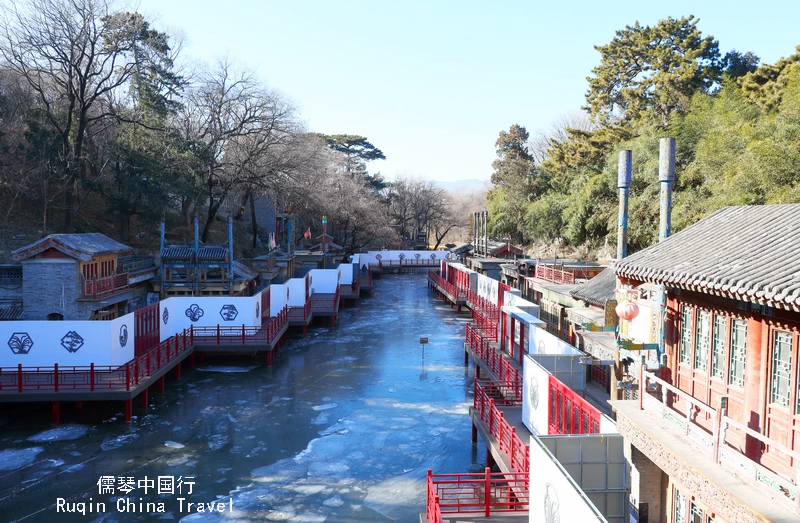
Sadly, Suzhou Street was destroyed by foreign forces in 1860, but it was rebuilt in 1990, preserving its historical essence as the only surviving example of an ancient imperial market. Stretching about 300 meters, the street is divided by water, with over 60 shops, 14 traditional archways, and eight charming bridges. Along its banks, you’ll find tea houses, restaurants, pharmacies, silk shops, and more—each offering a taste of old China’s vibrant commercial life.
Note: Suzhou Street is now under reconstruction from Oct, 2024 – Sept, 2026. But you still can visit Suzhou Street during the reconstruction.
2)The Four Great Continents: Buddhist Architecture at the Summer Palace
Nestled on the central axis of the rear mountain of Longevity Hill, the Four Great Continents (四大部洲)are a stunning collection of Buddhist buildings that merge both Han and Tibetan architectural styles. These buildings, facing north, are designed to represent the four continents in Buddhist cosmology: Nan Zhan Bu Zhou 南赡部洲 (Southern Continent), Bei Ju Lu Zhou 北俱卢洲 (Northern Continent), Dong Sheng Shen Zhou 东胜神洲(Eastern Continent), and Xi Niu He Zhou 和 西牛贺洲 (Western Continent).
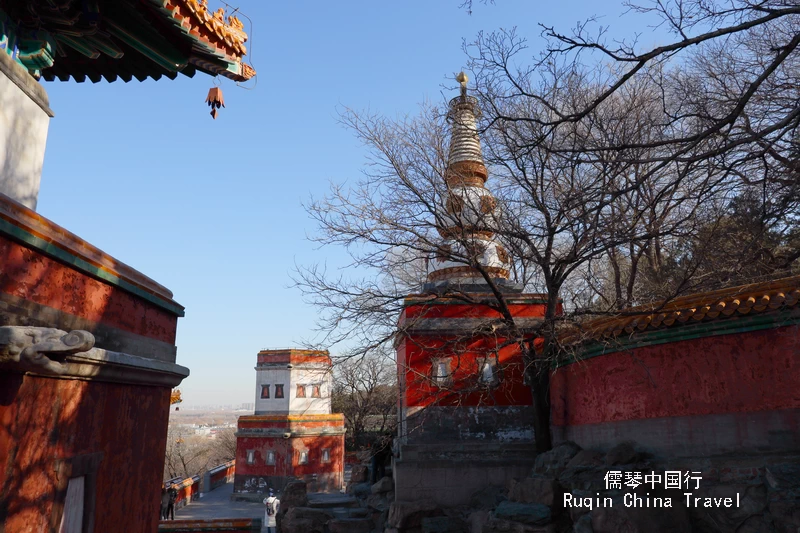
The design of these structures draws inspiration from the Samye Monastery 桑耶寺 in southern Tibet, one of Tibet’s oldest temples. Built during the 8th century, Samye Monastery is known for its unique blend of Tibetan Buddhist culture and architectural beauty. Visiting the Four Great Continents offers a glimpse into the deep connection between Chinese and Tibetan cultures, embodied in the harmony of these extraordinary buildings.
3) The Sea of Wisdom Hall(at the highest point of the Summer Palace)
The Sea of Wisdom Hall (智慧海) also known as the Hall Without Beams, is a religious structure located at the highest point of the Summer Palace. It sits atop Longevity Hill, north of the Tower of Buddhist Incense. The Sea of Wisdom Hall is constructed using intersecting archways, all made of stone and brick, with no wooden beams. This is why it is also called the “Hall Without Beams.” The exterior is adorned with beautiful yellow and green glazed tiles, while the roof is covered with a touch of purple and blue tiles, giving the entire building a vibrant and majestic appearance.
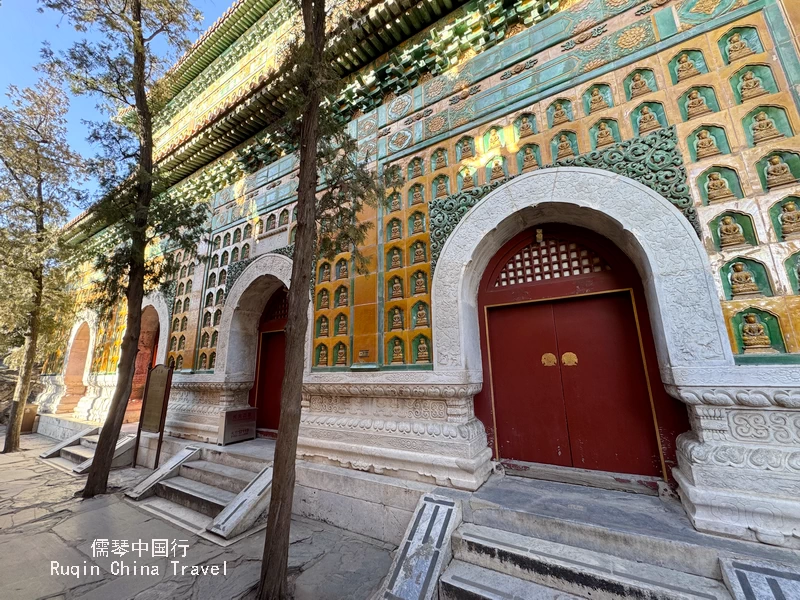
The history of the Sea of Wisdom Hall dates back to the Qianlong period of the Qing Dynasty (1736 – 1795), making it an architectural masterpiece of the time. However, during the Boxer Rebellion in 1900, the Sea of Wisdom Hall was severely damaged. The glazed Buddha niches on the outer walls were destroyed, and many of the Buddha heads were lost. The current statues are the result of recent restoration work. Despite the damage, the Sea of Wisdom Halls still stands proudly on top of Longevity Hill, continuing to be one of the key attractions at the Summer Palace.
3)Travel in Picture: a Garde within a Garden
The “Travel in Picture” (画中游) at the Summer Palace is a garden-within-a-garden featuring distinct mountainous characteristics. It was first built during the Qianlong reign and renovated during the Guangxu period. The “Travel in Picture” is built against the mountainside, offering a wide, open view. Walking along the corridors, it feels as if you’re stepping into a painting, hence the name “Travel in Picture.”
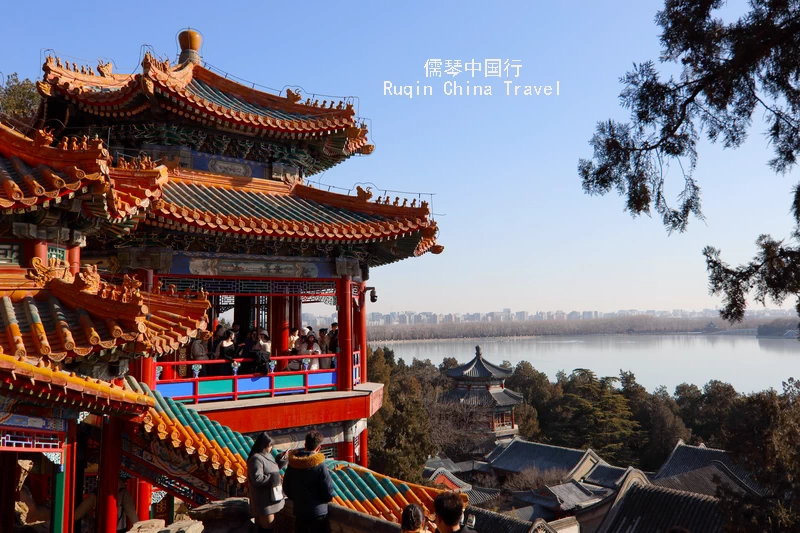
It is said that the name “Travel in Picture” originated from an unusual dream of Emperor Qianlong. In the 15th year of his reign (1750), while preparing for Empress Dowager Chongqing’s 60th birthday celebration, Qianlong dreamt of an elderly man with a long white beard, who was accompanied by two maidservants. Each maid held a painting scroll, and when unrolled, the paintings depicted pavilions, terraces, and gardens. The old man invited the emperor to travel into the paintings. Upon waking, Qianlong sketched what he had seen in his dream and used it as the blueprint to build the “Travel in Picture.”
4) The Marble Boat: A Symbol of History and Harmony
One of the most iconic landmarks at the Summer Palace is the Marble Boat (石舫), also known as the Qingyan Boat(清晏舫) Sitting gracefully on the western shore of Kunming Lake, just below the western foothills of Longevity Hill, it’s hard to miss this unique structure. The Stone Boat was first built in 1755 during the reign of Emperor Qianlong, and it was originally named Qingyan Boat. After it was rebuilt with Western elements, it was renamed to symbolize peaceful waters, a nod to the phrase “He Qing Hai Yan,” meaning harmony and prosperity.
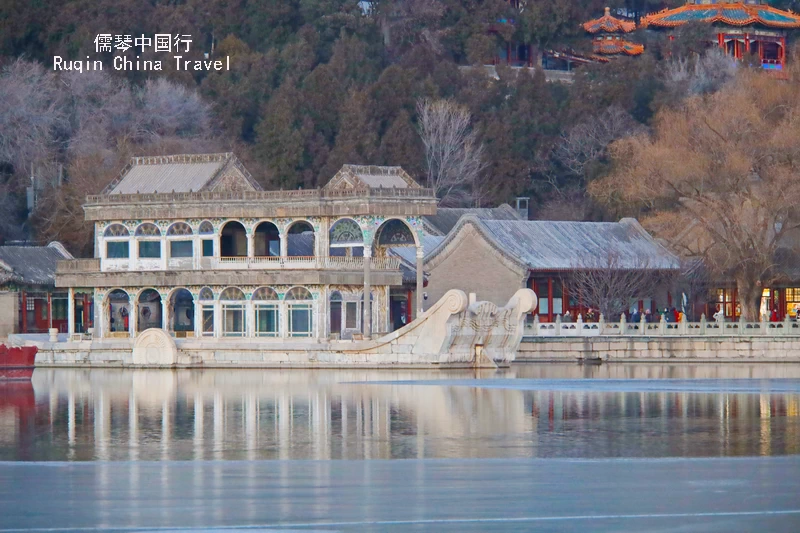
The Stone Boat is more than just a stunning piece of architecture. It stands as a silent witness to the rise and fall of the Qing Dynasty and reflects the blending of Chinese and Western cultures during the imperial era. Emperor Qianlong’s vision for the boat was rooted in his political philosophy. He sought to express the idea that “water can carry a boat, but it can also capsize it,” a metaphor for the delicate balance of power and governance.
5)The Long Corridor: the Longest Corridor in the World.
One of the most iconic features of the Summer Palace is the Long Corridor (长廊), stretching between the southern foothills of Longevity Hill and the northern shore of Kunming Lake. This stunning passageway was first constructed in 1750 during the Qianlong reign. Sadly, it was destroyed by British and French forces in 1860 but was later rebuilt in 1888.
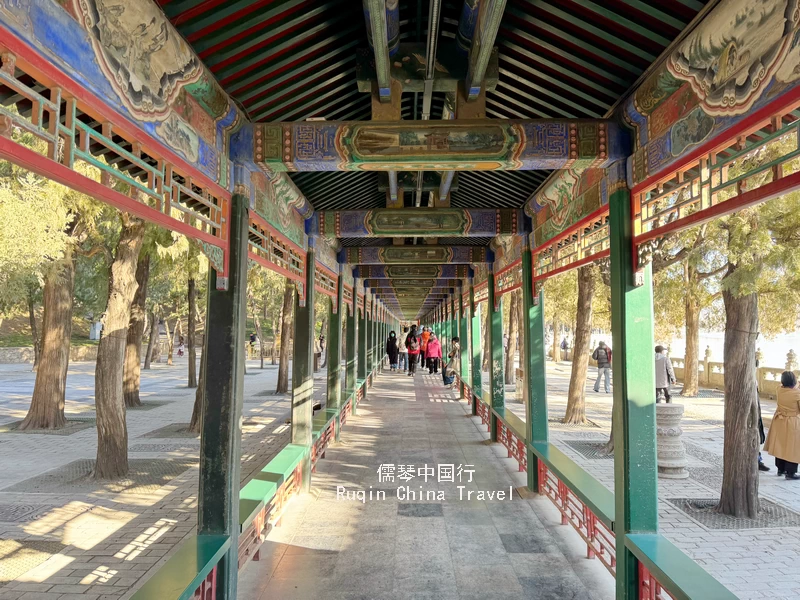
The Long Corridor is not just long—it’s extraordinary. It spans 728 meters, 273 pavilions each one representing the changing of the seasons. This makes it not only a symbol of the Summer Palace but also a perfect example of classical Chinese garden design.
In 1992, the Long Corridor earned a spot in the “Guinness World Records” as the longest corridor in the world. But what really captures visitors is the colorful murals that line its walls. Despite undergoing multiple restorations over the years, these vibrant paintings have preserved their historical beauty and continue to mesmerize countless tourists.
6) The Tower of Buddhist Incense:A Landmark of the Summer Palace
At the heart of the Summer Palace stands the Tower of Buddhist Incense 佛香阁 (Fuxiangge), one of its most iconic buildings. Perched on the front terrace of Longevity Hill, it offers breathtaking views of Kunming Lake to the south and the Hall of Dispelling Clouds. To the north, it faces the tranquil Sea of Wisdom. The tower was originally built in 1751 during the Qianlong reign but was destroyed by British and French forces during the Second Opium War. Fortunately, it was rebuilt in 1894, during the Guangxu reign.
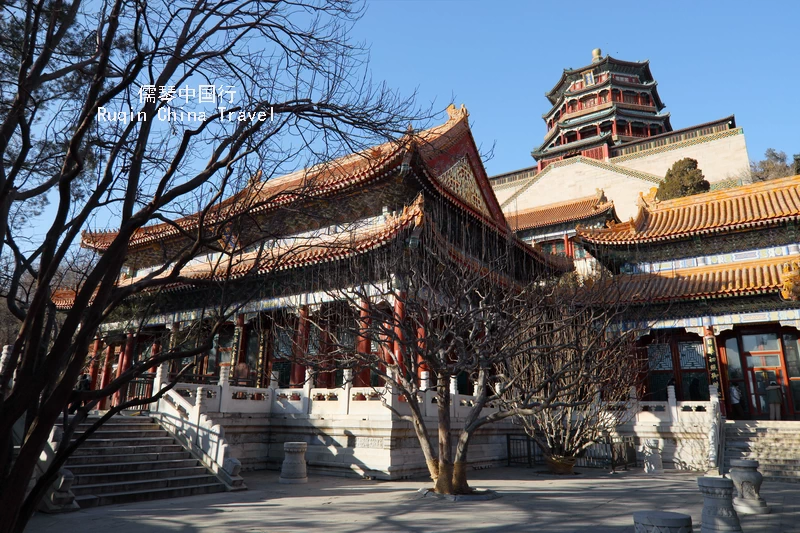
The Tower of Buddhist Incense is more than just a beautiful structure; it holds great historical and cultural significance. Its location alone makes it a key vantage point for panoramic views of the Summer Palace, while its history adds depth to the experience. Whether you’re admiring the stunning landscape or immersing yourself in the stories of China’s past, visiting the Tower of Buddhist Incense is a must when exploring the Summer Palace.
7)The Hall of Joy and Longevity: the Residence of Empress Dowager Cixi
Le Shou Hall 乐寿堂(The Hall of Joy and Longevity) is one of the most significant buildings in the Summer Palace. Originally built in 1750 during the Qianlong reign, it was designed as a sleeping palace for Emperor Qianlong’s mother to celebrate her 60th birthday.
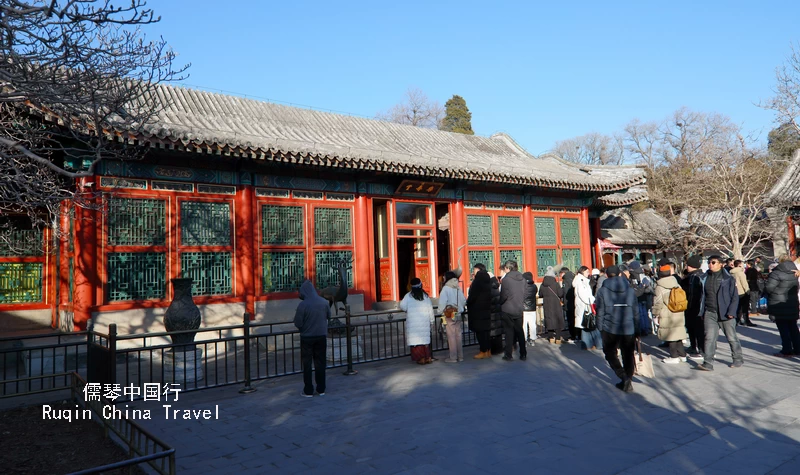
However, the hall’s story didn’t end there. In 1886, during the Guangxu reign, Empress Dowager Cixi renovated the Qingyi Garden and transformed Le Shou Hall into a more elaborate residence. She added two courtyards—one in the front and one in the back—connecting them with cross-courtyards to the east and west. The hall now included 49 rooms, all linked by long corridors.
Le Shou Hall then became the personal residence of Empress Dowager Cixi, and it became the center of her daily life. It was here that she managed the empire, making important decisions and receiving key figures. This building holds a unique place in Chinese history as the heart of the Qing dynasty’s later years.
8) Pavilion of Artistic Delight: The Residence of Empress Dowager Longyu
Tucked behind Yulantang in the Summer Palace, Yiyun Pavilion 宜芸馆 (Pavilion of Artistic Delight)is a quiet, historically rich building. Originally built during the Qianlong reign (1736-1795), it was later renovated during the Guangxu period (1875-1908). This pavilion was the residence of Empress Dowager Longyu, the wife of Emperor Guangxu.
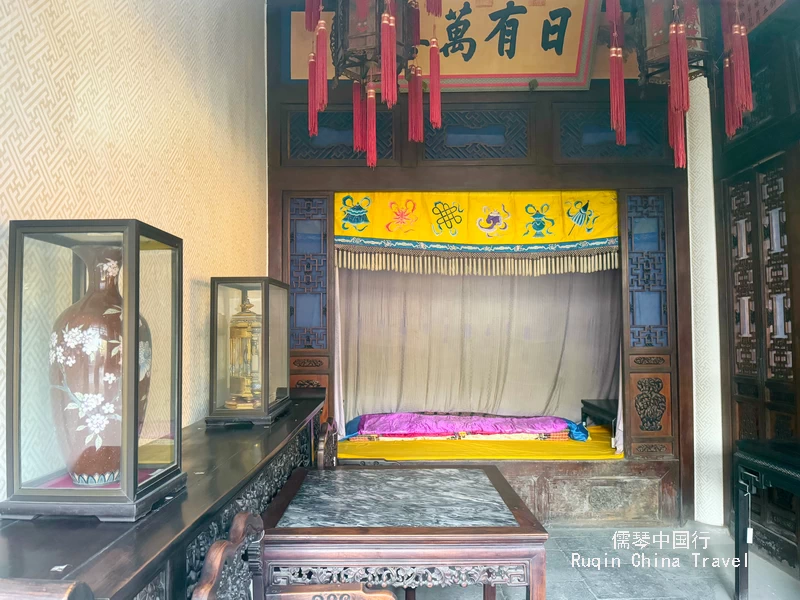
Yiyun Pavilion holds a special place in history. Empress Dowager Longyu, the niece of the powerful Empress Dowager Cixi, was made empress in 1889. But perhaps the most significant event tied to this pavilion occurred in 1912, when Longyu, acting as Empress Dowager, issued an edict forcing the Qing Emperor to abdicate. This event marked the end of the Qing dynasty and the fall of imperial China.
Today, Yiyun Pavilion stands as both a symbol of royal life and an important historical landmark. It serves as a quiet reminder of a time when power shifted and history was made.
9)The Grand Theater at Dehe Garden: A Royal Stage of History
The Grand Theater at Dehe Garden 德和园(Garden of Virtue and Harmony) is an architectural gem that tells the story of China’s royal past. Built in 1891 and completed in 1895, this impressive theater is 17 meters wide and 21 meters high. It features a unique three-level design, with two floors dedicated to the backstage and dressing rooms.
This theater is part of the “Three Major Opera Stages of the Qing Court,” which includes the Changyin Pavilion in the Forbidden City and the Qingyin Pavilion at Chengde Mountain Resort. These prestigious venues were where the Qing emperors and empresses enjoyed cultural performances, and Dehe Garden’s theater was a favorite spot for Empress Dowager Cixi herself.
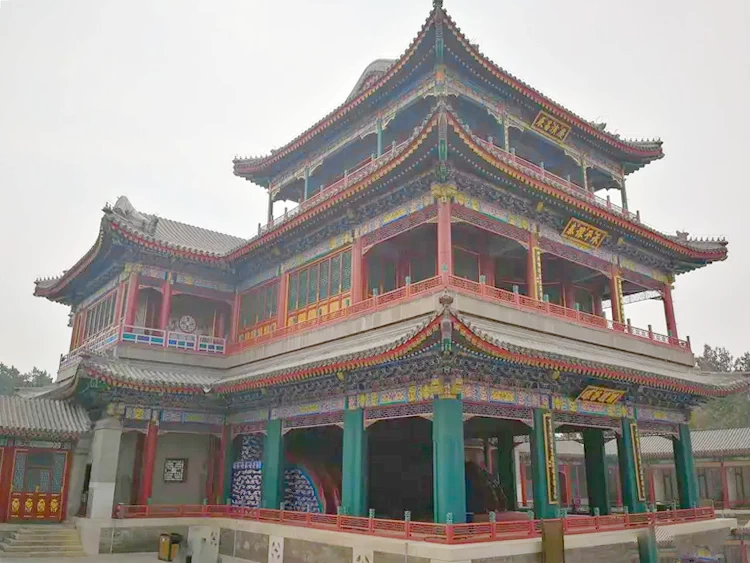
Visitors today are drawn to the Grand Theater not just for its stunning design but for its rich historical backdrop. The three-story structure is especially unique, with entrances on each level. This clever design allows for multiple performances to happen at the same time, adding a layer of interaction and variety for spectators. It’s easy to imagine the grandeur of the Qing court as you explore this incredible building.
10) Hall of Benevolence and Longevity: A Symbol of Qing Dynasty Power
Located just inside the East Palace Gate of the Summer Palace, the Hall of Benevolent Longevity 仁寿殿 (Ren Shou Dian) is one of the most important buildings in the palace’s political area. Originally built in 1750 under Emperor Qianlong, the hall was first named the Hall of Diligent Administration. Unfortunately, it was destroyed by British and French forces during the Second Opium War in 1860, but was later rebuilt in 1886 during the reign of Emperor Guangxu and renamed the Hall of Benevolent Longevity.
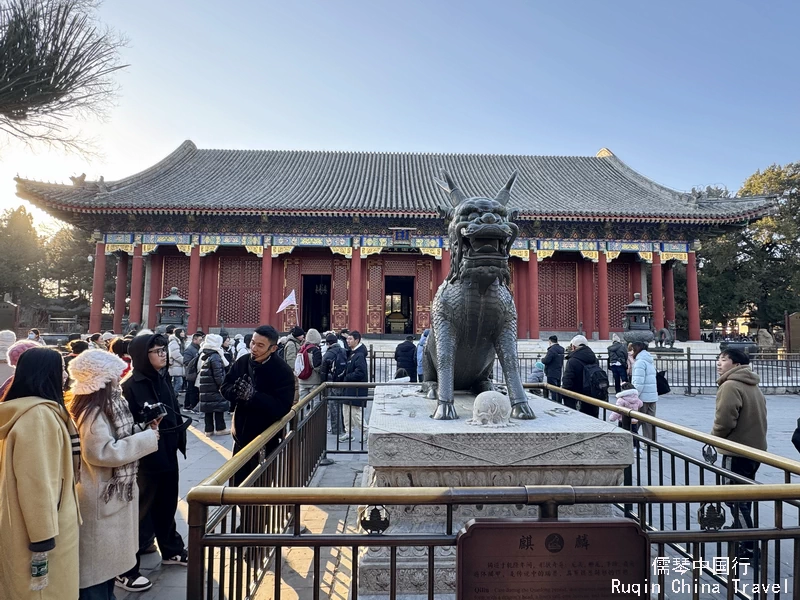
This hall played a central role in the Qing Dynasty’s governance. It was here that Empress Dowager Cixi and Emperor Guangxu would hold meetings, discuss state matters, and receive foreign diplomats. But the Hall of Benevolent Longevity also carries deep historical and cultural significance. Its architectural design is a fusion of traditional Chinese style with Western influences, a testament to the openness and inclusiveness of the era.
11) The Hall of Jade Ripples:The Sleeping Quarters of Emperor Guangxu
Nestled along the serene shores of Kunming Lake, Yulantang 玉澜堂 (The Hall of Jade Ripples) is a significant building within the Summer Palace. Originally constructed in 1750 during the reign of Emperor Qianlong, it was destroyed by fire in 1860 but was rebuilt in 1892. Yulantang became the sleeping quarters of Emperor Guangxu and holds a dark place in history. After the failure of the 1898 Reform Movement, Empress Dowager Cixi confined Emperor Guangxu here, making it a symbol of political struggle.
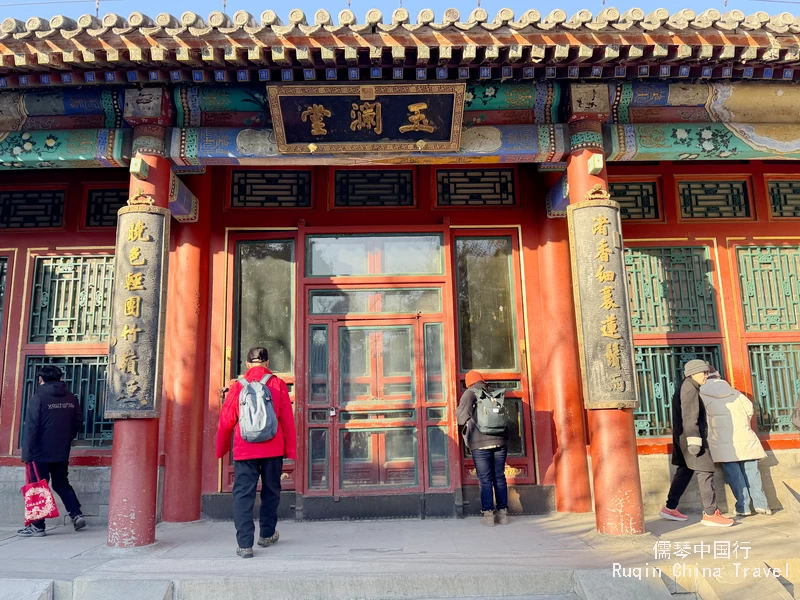
Yulantang’s architectural beauty hides a turbulent past. In 1898, following the failed reform attempt, Empress Dowager Cixi took drastic steps to keep the emperor under her control. She locked down the hall by sealing off the entrances on the east, west, and north sides, leaving only the southern entrance, guarded by her loyal eunuchs, as a point of access.
12) The East Causeway: A Journey Through Scenic Beauty
The East Causeway (东堤) of the Summer Palace is a scenic pathway that runs along the eastern edge of Kunming Lake. Stretching for about two kilometers, it begins at the Heralding Spring Pavilion and Wenchang Pavilion in the north and ends at the South Ruyi Gate in the south. The entire causeway is paved with bluestone, adding a traditional touch to its natural beauty.
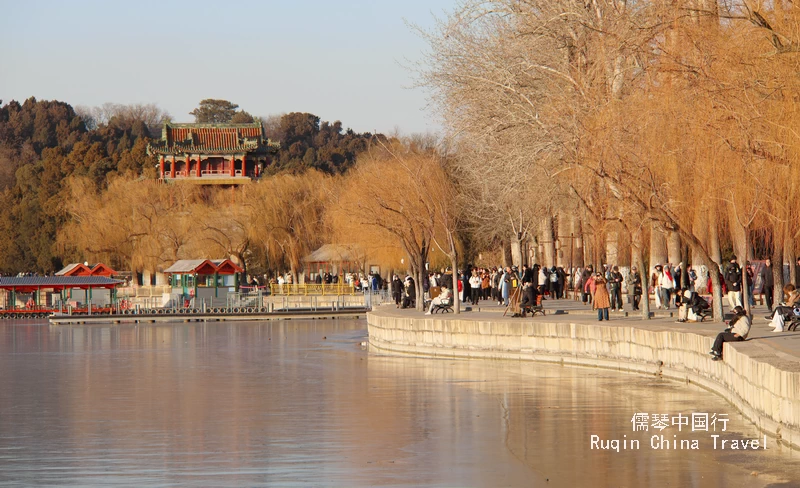
As you walk along the East Causeway, you’ll be captivated by the contrasting scenery. On one side, the calm waters of Kunming Lake stretch out before you, while on the other side, tall poplar trees line the path, creating a peaceful, shaded walkway. The landscape is beautifully layered, with distinct foreground, middle ground, and background views. It’s a spot where the vastness of nature and the elegance of imperial architecture come together in perfect harmony.
Along this picturesque path, you’ll find several must-see landmarks. The Summer Palace Museum, Wenchang Pavilion, the iconic Bronze Ox, and the 17-Arch Bridge are just a few of the notable sights. Each one adds its own charm to this already stunning route, making the East Causeway a highlight of any visit to the Summer Palace.
13) The Heralding Spring Pavilion: A Scenic Retreat at the Summer Palace
Zhichun Pavilion 知春亭 (Heralding Spring Pavilion)is one of the most distinctive structures in the Summer Palace. With its unique double-eaved, four-cornered roof, it stands on 12 sturdy columns, featuring vibrant yellow glazed tiles and red pillar railings. Surrounding the pavilion are graceful weeping willows, which bloom beautifully every spring, adding to the allure of the place. As the willows begin to bud each year, the scenery becomes even more enchanting.
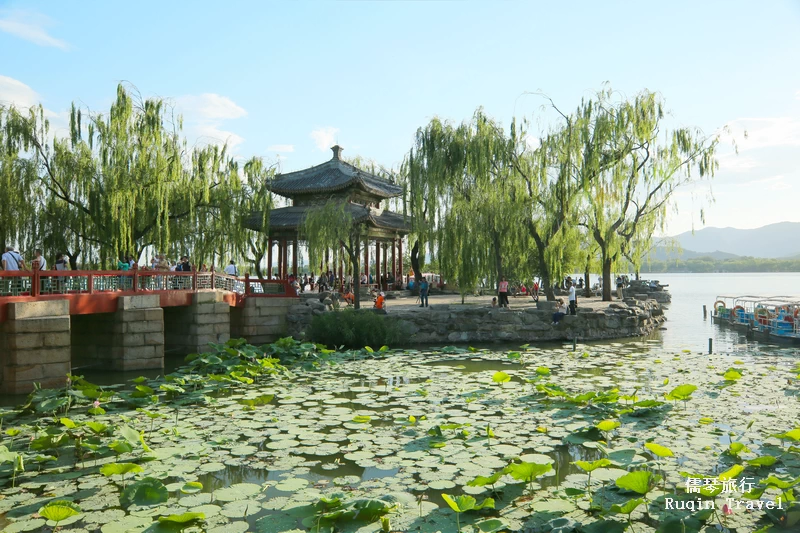
The name “Zhichun” is derived from a poem of the Song Dynasty, “The warm spring river knows first by the ducks.” Kunming Lake’s thawing always begins here, marking the first sign of spring’s arrival. This makes Zhichun Pavilion not just a scenic spot, but also a symbol of renewal and the changing seasons.
From the pavilion, you can enjoy stunning panoramic views of the Summer Palace’s natural beauty. The vistas stretch across Longevity Hill, Kunming Lake, and the distant Jade Spring Hill. Standing there, you can feel the gentle spring breeze and admire the breathtaking blend of water and mountain views—truly a perfect place to take in the peaceful landscape.
14) The Summer Palace Musuem: A Glimpse into China’s Royal Past
Nestled on the eastern shore of Kunming Lake, next to Wenchang Pavilion, the Summer Palace Museum offers visitors a unique chance to delve into China’s royal history. With its design inspired by both Chinese and international museums, the museum seamlessly blends modern architecture with the grandeur of imperial China. The layout combines storage rooms and exhibition halls, covering a vast area of 2,777 square meters for exhibits.
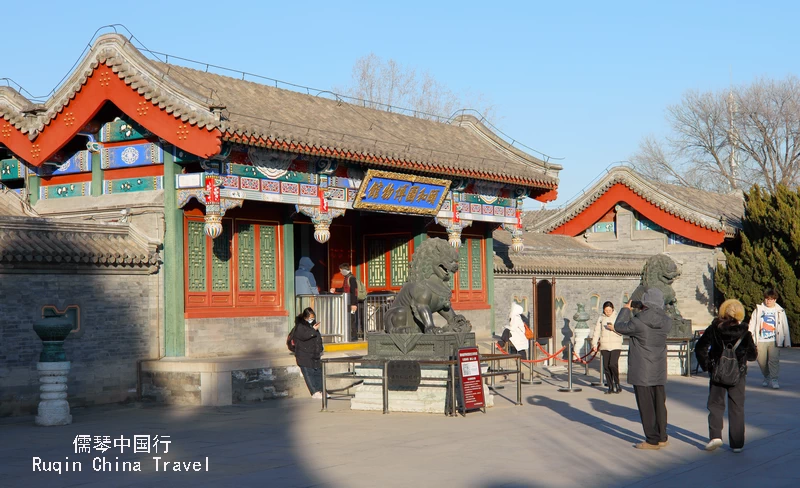
Inside, the museum is divided into six themed galleries. Here, you’ll find an extensive collection of treasures, showcasing nearly 3,000 years of Chinese history, from the Shang and Zhou Dynasties to the late Qing Dynasty. The artifacts on display include a variety of objects such as intricate bronze wares, delicate jade pieces, fine porcelain, and precious gold and silver items. You’ll also see bamboo, wood, ivory, and horn crafts, as well as lacquerware, furniture, and stunning calligraphy and paintings.
15)The Bronze Ox: A Symbol of Strength and Stability at the Summer Palace
On the eastern shore of Kunming Lake, the Bronze Ox stands as a reminder of both imperial power and the importance of water control. Commissioned by Emperor Qianlong in 1755, this lifelike ox is also known as the “Golden Ox.” It’s an impressive 1.8 meters long and 1.2 meters tall, with proportions that closely match those of a real ox. The ox’s form is remarkably realistic, capturing the strength and grace of the animal.
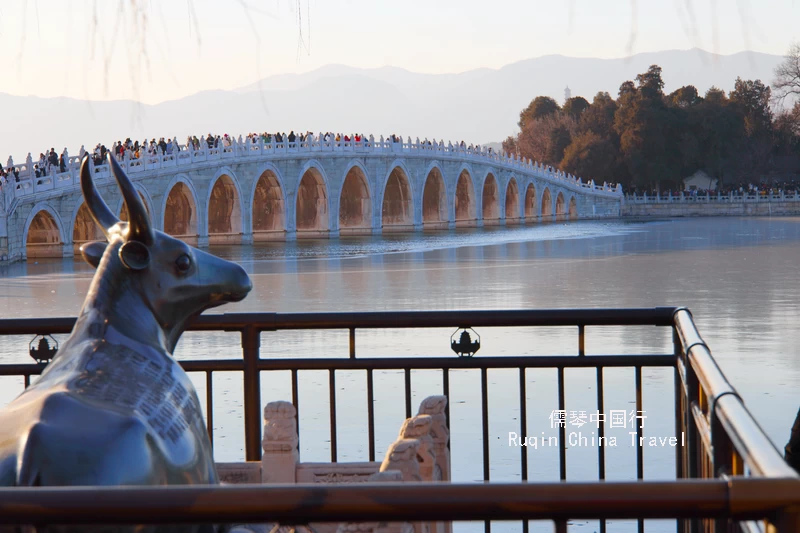
On its back, you’ll find an inscription of four characters, “Eight Hundred Li Golden Ox,” written by Emperor Qianlong himself. The inscription tells the story of Emperor Yu, who controlled the floods and brought peace to the land. It’s a symbolic reminder of the role of water management in ensuring stability.
16) The 17-Arch Bridge: A Majestic Crossing at the Summer Palace
The Seventeen-Arch Bridge, an iconic structure at the Summer Palace, stretches across Kunming Lake, linking the eastern shore to Nanhu Island. Built during the 15th year of the Qianlong reign (1750), this stunning bridge is 150 meters long. Its base spans 14.6 meters, while the top is 6.56 meters wide and stands 7 meters tall.
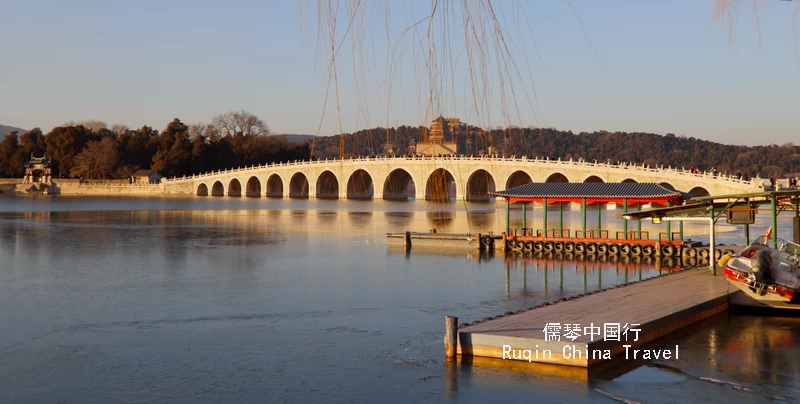
As the day draws to a close, the setting sun casts a golden glow over the bridge, transforming it into a shimmering path of light. The Seventeen-Arch Bridge appears even more regal and ancient, its beauty heightened by the warm, golden hues of the sunset.
Note: This “First Timers’ Best Travel Route” is adjustable:
- This route is not suitable for wheelchair users. For accessible travel, you can skip the Four Great Continents and the Tower of Buddhist Incense.
- You may also enter through the East Palace Gate and customize the route according to your needs.
- The travel route can be completed at the East Palace Gate.
4. Summer Palace Ferry Boat Routes
The ferry boats at the Summer Palace offer a unique way to explore the park, allowing you to enjoy scenic views while saving time by avoiding backtracking. One of the most popular ferry routes is the round-trip journey from Shizhang Pavilion to Bronze Ox.
If you enter through the East Gate and plan to visit the Long Corridor, you can take the ferry from Shizhang Pavilion on the northwest shore of the Kunming Lake to Bronze Ox or Seventeen-Arch Bridge, eliminating the need to retrace your steps. It’s a convenient and scenic way to experience the beauty of the Summer Palace without doubling your walk.
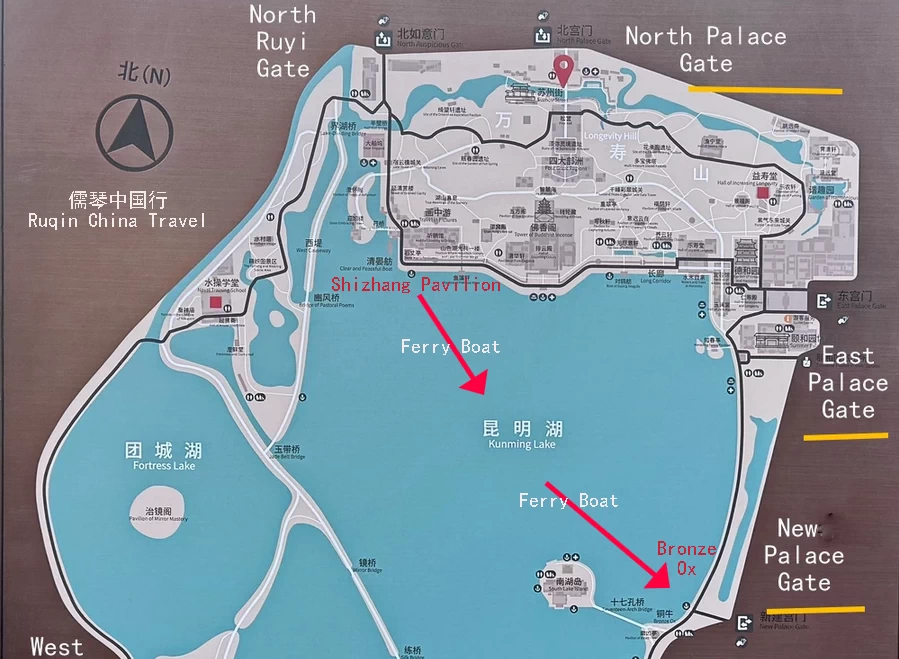
The Summer Palace offers four main boat routes (totally 11), running daily from 8:30 AM to 5:30 PM. Tickets for the boats are priced at 40 yuan per person for a one-way trip, making them ideal for individuals, families, or groups. Here are the available routes:
- Shizhang Pavilion (石丈亭) to Bronze Ox (铜牛) – 40 yuan per person.
- Stone Boat to South Lake Island – 40 yuan per person.
- Paiyun Gate Circular Tour around the Lake – 40 yuan per person.
- Seventeen-Arch Bridge to Suyun Yan – 40 yuan per person.
Each boat operates approximately every 15 minutes, though you might need to wait during less crowded times. Children under 1.2 meters can ride for free.
The Summer Palace winter boat tours will be suspended.
Helpful Tips
Respect nature: Be mindful of the environment. Don’t throw trash into the water, and avoid disturbing or feeding the waterfowl and other wildlife.
Weather-related suspensions: The boats may stop operating during strong winds, heavy rain, or other extreme weather conditions. Make sure to check the official Summer Palace Weibo or the signs at the gates and piers for updates.
Plan your visit wisely: During weekends and public holidays, waiting times can be longer. If possible, visit during off-peak hours to avoid the crowds.
Safety first: Always wear a life jacket when riding the boats. Keep steady and seated during the journey. Please refrain from running, playing, or letting children steer the small boats.
5. Best Time to Visit the Summer Palace
The best seasons to visit the Summer Palace are spring and autumn. These two seasons offer the most pleasant weather and breathtaking views.
In spring (March to May), the gardens are alive with colorful flowers. Cherry blossoms, peach flowers, and azaleas bloom, filling the air with fragrance. The entire park seems to come alive, with clear lake waters reflecting the sky. A gentle breeze ripples across the surface, creating shimmering waves. Taking a boat ride on the lake brings a deep sense of peace and beauty, letting you fully enjoy nature’s serenity.
Autumn (September to November) is another magical time to visit. The trees on Longevity Hill are ablaze with vibrant red leaves. The hillsides are painted in every shade of autumn. Walking along the long corridor, surrounded by these fiery colors, feels like stepping into a fairytale world. The landscape is simply stunning.
Summer (June to August) is also a great time to explore the Summer Palace. Though the weather can be hot, the lush trees and cool lakes provide a refreshing escape. The long corridor, the artificial hills, and the pavilions are shaded by greenery. You can enjoy a walk in the shade, with the breeze off the lake making it even more pleasant. A boat ride on Kunming Lake during summer is particularly enjoyable, offering a cool, relaxing experience.
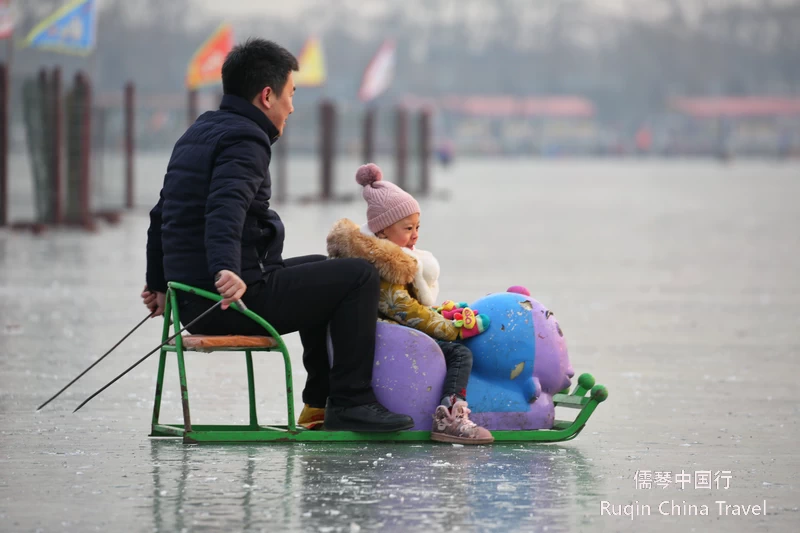
Winter (December to February) is quieter, but it has its own charm. While the flowers and trees are absent, the tranquility of the Winter Palace is captivating. The pavilions,hills and rocks are all covered in snow, creating a beautiful winter wonderland. Kunming Lake often freezes over, and visitors can ice skate or play on the ice, embracing the joy and energy of the winter season.
Each season at the Summer Palace offers something unique. Whether it’s the colorful flowers of spring or the quiet snow of winter, every visit promises a new experience.
6. Summer Palace Opening Hours
Peak season (April 1 – October 31) : Open at 6:00, last entry at 19:00, close at 20:00.
Off-season (November 1 – March 31) : Open at 6:30, last entry at 18:00, close at 19:00.
The inside paid attraction courtyard opening hours:
(1) Buddha Pavilion, Garden of Virtue, Summer Palace Museum, Suzhou Street
Peak season (April 1 – October 31) : Open at 8:00, last entry at 17:30, close at 18:00.
7. Off-season (November 1 – March 31) : Open at 8:30, last entry at 16:30, close at 17:00.
The above attractions are closed on Mondays (except statutory holidays).
7. Summer Palace Tickets
The Summer Palace offers different ticket prices depending on the season. During peak season (April 1st to October 31st), the entry fee is 30 yuan. If you choose the combined ticket, which grants access to the paid attractions within the Summer Palace, the price is 60 yuan.
In the off-season (November 1st to March 31st), the ticket prices drop. The entrance ticket costs 20 yuan, and the combined ticket is available for 50 yuan.
Additional Tickets for Special Areas
The Summer Palace has several special areas that require an additional entry fee:
- Dehe Garden: 5 yuan
- Tower of Buddhist Incense: 10 yuan
- Suzhou Street: 10 yuan
- Museum: 20 yuan
If you have purchased the combined ticket, you do not need to buy separate tickets for these attractions within the Summer Palace.
Discounts
Visitors who are 6 years old or younger and 60 years old or older can enjoy free entry. There are also discounted tickets available for eligible visitors. The price for discounted individual tickets is 15 yuan, and for the combined ticket, it’s 30 yuan.
Booking Information
You can reserve your tickets in advance via the Summer Palace’s official WeChat account. Be sure to book at least 7 days before your visit to secure your spot. Or you also buy the tickets on the spot at the each entrance.
8. How Long to Visit Summer Palace
Experience Summer Palace in Beijing fully with at least half a day, or ideally a full day. This allows ample time to explore the gardens, historical buildings, and scenic Kunming Lake.
Wander along the Long Corridor, adorned with vibrant paintings, and visit landmarks like the Hall of Benevolence and Longevity for insights into imperial history. Enjoy picturesque views from Longevity Hill and consider a boat ride on Kunming Lake.
Whether you visit in summer, with blooming gardens, or winter, with the lake frozen for ice skating, each season offers unique charm at Summer Palace. Plan your visit to enjoy a relaxed pace amidst Beijing’s bustling cityscape, soaking in both cultural splendor and natural beauty.
9. Official Tour Guide Services from Summer Palace
You can easily pick up an electronic audio guide at several entrances, like the East Palace Gate or North Palace Gate. These guides are available in 19 languages, so you can choose the one that works best for you.
While the Summer Palace does offer live tours, I’d recommend sticking with the audio guide or an official tour, as private guides at the entrance are often unofficial and can be a bit hit or miss.
If you’re set on a live guide, you can book one in advance at the official service desks (you can reach them at: 62865056 or 62881144-6430), but keep in mind that it’ll involve a bit more paperwork and usually costs more.
Summer Palace Tour Routes:
Route 1: East Palace Gate – Hall of Benevolence and Longevity – Garden of Virtue and Harmony – Hall of Joyful Longevity – Long Corridor – Cloud-Dispelling Gate – Marble Boat
Route 2: North Palace Gate – Suzhou Street – Central Axis Road – Su Yun Yan – Marble Boat – Long Corridor – Cloud-Dispelling Gate – Hall of Joyful Longevity
Route 3: New Palace Gate – Bronze Ox – East Causeway – Pavilion of Literary Prosperity – Hall of Benevolence and Longevity – Garden of Virtue and Harmony – Hall of Joyful Longevity – Long Corridor – Cloud-Dispelling Gate.
10. Snacks and Beverage Shops in the Summer Palace
The Summer Palace offers several snack and beverage shops where visitors can take a break and enjoy some local treats. One of the highlights is Xijiujian Yihe Food Court (西九间·颐和食坊).
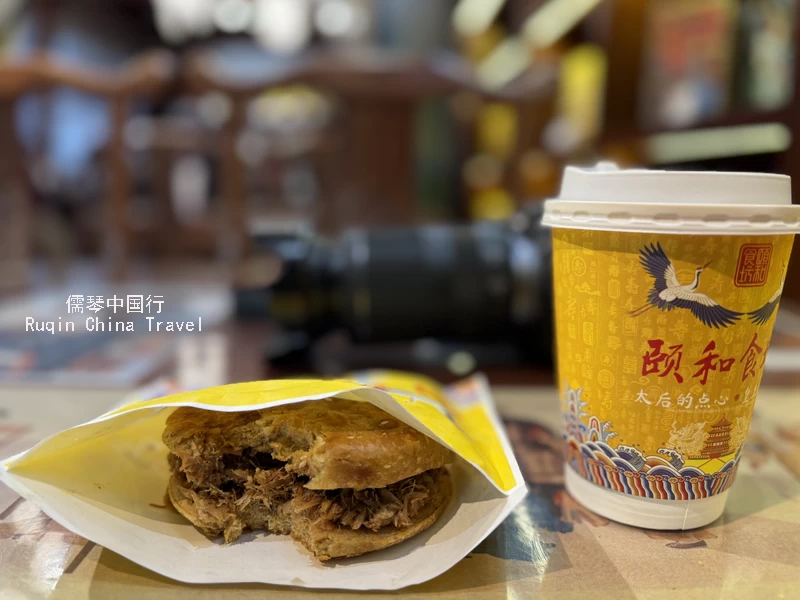
This spot serves popular court snacks like Yuanmeng Shaobing (dream round flatbread) favored by Empress Dowager Cixi.
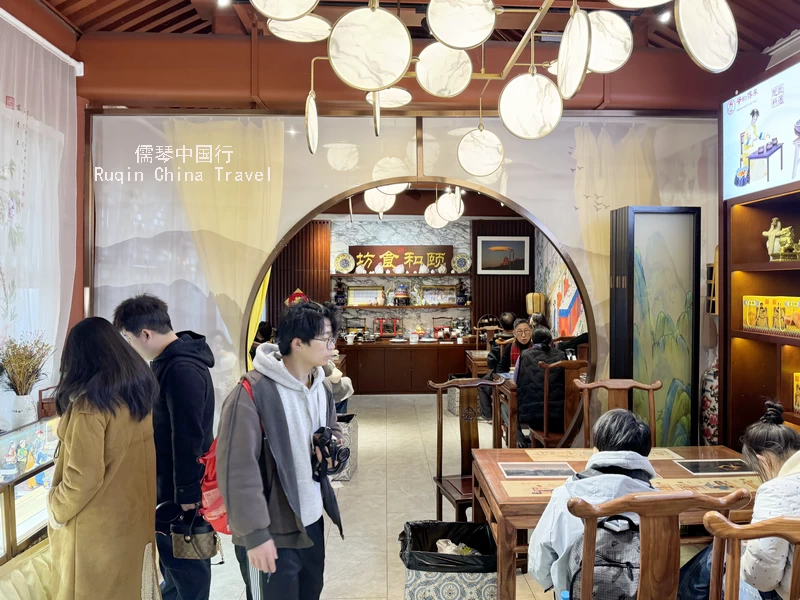
Xijiujian Yihe Food Court is conveniently located in the middle of the Long Corridor, making it an ideal place to stop for a quick snack while exploring. With prices around 29 yuan, it offers great value and is perfect for those who want to eat while sightseeing. You can also relax and sit down in the restaurant, where they serve coffee and other drinks.
Other Snack and Beverage Shops
Apart from Xijiujian Yihe Food Court, there are several other snack and beverage spots scattered throughout the Summer Palace, offering a variety of drinks and light snacks. Here are some options:
- Zhi Chun Pavilion Shop: Located at Zhi Chun Pavilion, this shop offers a range of packaged snacks and beverages.
- Renshou Palace Food Shop: Situated at Sanjianfang, you’ll find coffee, milk tea, and various packaged snacks and drinks.
- Yulan Hall Photography Shop: Found near Jiudao Wan, this shop offers an assortment of packaged snacks and drinks.
- Dui’ou Fang: Here, visitors can enjoy coffee, milk tea, and a selection of packaged snacks and drinks.
- Paiyun Hall Shop: Located near the entrance of Paiyun Hall, this shop provides various packaged snacks and beverages.
- Stone Boat Craft Food Shop: Located at the Stone Boat, it offers coffee, milk tea, and a variety of snacks and drinks.
- Jingtai Lan: This shop specializes in various packaged snacks and beverages.
- Yingxu Tower: Another spot where visitors can enjoy packaged snacks and drinks.
These convenient spots allow visitors to relax and refresh during their visit, with something for everyone—from sweet treats to hot beverages.
11. Guide for People with Walking Difficulties
For visitors with walking difficulties, the Summer Palace is thoughtfully equipped to ensure a comfortable and enjoyable experience. Wheelchairs are available free of charge at each entrance gate, requiring only a refundable deposit of 500 yuan. These can be a great help for navigating the vast expanses of the palace grounds.
In addition, the palace offers convenient boat rides from the Marble Boat area, allowing visitors to explore the beauty of Kunming Lake without the need for extensive walking. This is an excellent option for those who wish to experience the tranquility and scenic views of the lake area with minimal physical strain.
The paths around the main attractions like the Long Corridor, Kunming Lake, and the major palaces are relatively flat and well-maintained, making them accessible for wheelchairs. Furthermore, many of the rest areas are equipped with seating facilities, providing ample opportunities to rest and relax.
Visitors should also note that some areas of the palace, particularly those on Longevity Hill, involve steep steps and uneven terrain. It’s advisable to plan your route accordingly and perhaps focus on the more accessible areas if mobility is a concern.
With these facilities and considerations in place, the Summer Palace remains an inclusive destination, ensuring that its historical and cultural riches are accessible to all visitors, regardless of their mobility levels.
12. Best Time and Spots for Photography in the Summer Palace
If you’re planning to capture the beauty of the Summer Palace, timing and location are key. Here’s a guide to help you make the most of your photography experience.
Best Times to Shoot:
6:00 AM – 10:00 AM
This is the golden hour for photos. The crowds are thinner, and the sunlight is soft and flattering. Plus, many areas and attractions like the pier, Xiequ Garden, and the Travel in Picture open only after 8:00 AM. So, you can enjoy most of the main spots before the crowds arrive.
After 4:00 PM
The light softens in the late afternoon, creating the perfect conditions for sweeping landscape shots. It’s an excellent time to capture the Summer Palace’s serene beauty in warm, glowing light.
1-2 Hours Before and After Sunset
For stunning, backlit shots, head to the Seventeen-Arch Bridge (near the new palace gate) or the West Causeway (near the West Gate). You’ll get amazing views of Jufeng Tower against the backdrop of the distant mountains, with the sun casting a golden hue over the landscape.
Best Photography Locations:
South Lake Island
This spot is perfect for capturing the famous “golden sunlight piercing through the arches of the 17-arch bridge.” Aim to arrive around 3:30 PM for the best light. If you’re interested in time-lapse photography, consider coming even earlier.
Seventeen-Arch Bridge
Near the new palace gate, this area offers fantastic photo opportunities during the golden hour, especially 1-2 hours before and after sunset.
West Causeway
Close to the West Gate, this location also provides breathtaking views during sunset. Again, the 1-2 hour window before and after sunset is ideal for capturing the light.
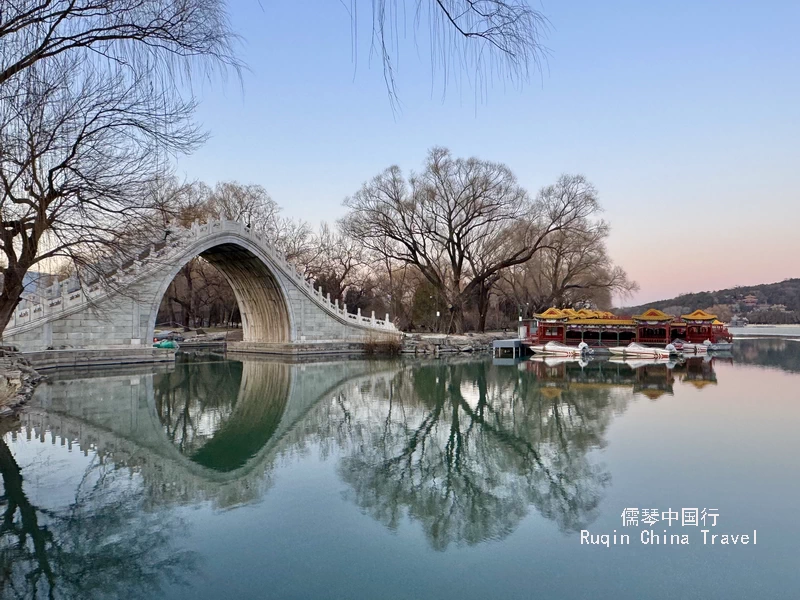
Travel in Picture (Hua Zhong You)
Early mornings here are perfect for photos, as it’s quieter and the light is much better.
The Summer Palace is a magnificent blend of natural beauty and historical grandeur. Whether you are a history buff, nature lover, or simply in search of tranquility, we hope this Summer Palace Travel Guide will ensure you to have an enriching and unforgettable experience in the heart of Beijing.
More Beijing Travel Guides
Planning your Beijing tour? Our “Beijing Travel Guide“ section offers essential advice to help you navigate the city like a pro. From transportation tips and local customs to insider recommendations for hidden gems, these travel tips will ensure you have a smooth, enjoyable, and unforgettable experience in China’s vibrant capital. Let us guide you through the best practices for exploring Beijing with confidence!

